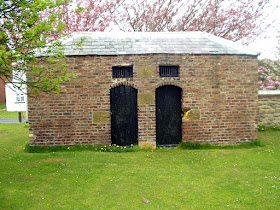The lock-up in North Street, Haworth was demolished towards the end of the 20th century.
It had latterly been used as a shop and a picture of it can be seen at :
oooooooooooooooooooooooooooooooooooooooooooooooooooooooo
The lock-up in the 'Last of the Summer Wine' village of
Holmfirth in West Yorkshire, is in Daisy Lane behind the Holy Trinity Church, HD9 1RP. Known as 'Th'owd Towser' it is a listed building. As the blue plaque tells us, it stands on the site of the original church lock-up built in or soon after 1597. It was rebuilt in the early 19th century and served as a lock-up and watch room on the upper floor and the large lower floor as a mortuary and fire/ambulance station.
It was Grade 11 listed 4.8.1983 and described as :
Former detached lock up. Early C19. Hammer dressed stone. Stone slate roof. Two
storeys. North elevation: large carriage doorway with massive stone lintel supported
on rounded padstones. Doorway to east and south elevtions (the latter blocked). West
elevation: first floor has narrow slit opening with vertical bar .
Source: English Heritage
Listed building text is © Crown Copyright. Reproduced under licence.
 |
HOLMFIRTH
OS Grid Reference: SE1430208197
OS Grid Coordinates: 414302, 408197
Latitude/Longitude: 53.5702, -1.7855
The smaller of the two upper rooms was the lock-up and an iron ring, which is still set into the floor, was used to restrain violent prisoners. There is also a ledge which was used for a candle.
The larger room was for the use of the Constable and The Nightwatch.
It is not known where the term 'towser' comes from. It has always been a favourite name for a dog and I wonder if it meant to refer to the 'dog house'.
The lock-up held an unusual prisoner in 1685 when the Rev. Edward Robinson was detained therein whilst awaiting his removal to York. Robinson who was the assistant parish priest, was arrested for the capital offence of 'coining'. Coining was prevalent in the area at that time and consisted of cutting the edges off gold coins to produce an accumulation of gold which was then expertly moulded into a counterfeit coin. He was found guilty at York Assizes and hanged.
Photographs by Roy Pledger,
ooooooooooooooooooooooooooooooooooooooooooo
The lock-up at Horbury, also in West Yorkshire, is situated in Tithe Barn Street, WF4 6GL and dates to c1710. The single cell lock-up, known as 'The Kidcote' was on the ground floor with accomodation for the gaoler or constable on the upper floor which was accessed via an external stone staircase.
HORBURY
OS Grid Reference: SE2943418370
OS Grid Coordinates: 429434, 418370
Latitude/Longitude: 53.6610, -1.5560
It was Grade 11 listed 6.5.1988 (No.342513) and described as :
Former lock-up. Early C19. Coursed, squared rubble with quoins. Stone slate roof. Two storeys. Single cell. Entrance in gable front with studded door. Rear has small window with iron grill to ground floor, left. A stone stair leads to lst floor entrance with stone surround. Small window at high level to each side elevation. Interior: not inspected. The building's ground floor was used as the town lock-up .
Source: English Heritage
Listed building text is © Crown Copyright. Reproduced under licence.
Tythe Barn Street
It is not certain why this lock-up is known as 'Kidcote'. Literally meaning 'little goat house' it may be a dialect word of medieval origin along the lines of a pigeon cote and may be a facetious term.
Old lock-ups at York and Wakefield had the same name.
Photographs by Roy Pledger.
ooooooooooooooooooooooooooooooooooooooooooooooooooooo
The lock-up at Hunmanby in North Yorkshire is situated on a green at 1 Sheepdyke Lane, YO14 0PP. Known as The Black Hole, is has two cells and dates to 1834 (datestone). The village pinfold is alongside.
HUNMANBY
OS Grid Reference: TA1013177531
OS Grid Coordinates: 510131, 477531
Latitude/Longitude: 54.1817, -0.3140
It was Grade 11 listed 11.1.1952 (No.327000) and described as :
Lock-up. 1834 on datestone. Blue and pink brick in English Garden wall
bond;
stone dressings; slate roof. 2-cell, rectangular on plan. Single-
storey.
Paired boarded doors at centre, under segmental arches of gauged
brick
divided by pier with stone impost block and single stone quoin to each
outer
jamb. Horizontal iron grilles over each door with the datestone
between.
Hipped roof. Also known as the Black Hole .
Source: English Heritage
Listed building text is © Crown Copyright. Reproduced under licence.
Datestone clearly marked AD 1834
Local man, Ces Mowthorpe wrote about the lock-up in 2007 as follows:
|
.JPG)









No comments:
Post a Comment